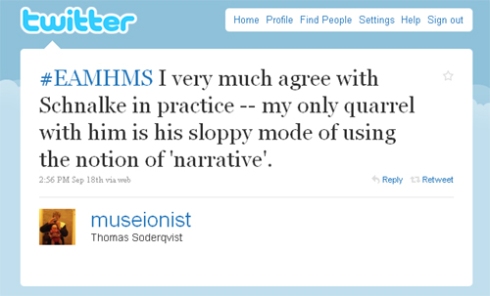Taking our Twitter session at the EAMHMS conference two weeks ago (“a qualified kind of success”) as his point of departure, Danny Birchall (Museum Cultures) summarizes his view of the pros and cons of conference-tweeting:
On the negative side conference-tweeting tends to be personally distracting (and possibly insulting to a speaker forced to regard an audience gazing deep into their phones and laptops); susceptible to triteness and glib summation rather than reflective thought; and elitist: it excludes from a conversation those without the appropriate technology or ability to cope with distraction.
On the positive side, it provides a kind of collective note-taking, accessible even to those not involved; it provides for an additional, multiplicitous and open conversation, not directed through a chair; and sometimes allows for people not present at the conference but connected to its participants, to join in the conversation and bring new information and perspectives to it.
Despite the fact that only four of us tweeted throughout the conference, and that for half of it there was no wifi available, we did a not not bad job, and towards the end of the conference did indeed begin to get others chipping in, asking what ‘the problem of the medical museum’ was, and questioning our assertions about the situatedness of art.
With reference to one of the last tweets I wrote during the EAMHMS-conference (while we were discussing Thomas Schnalke’s presentation),

I would like to add to Danny’s pros and cons:
Tweeting during a conference allows you to make much more succinct statements than you will usually make in the oral discussion. I don’t think I would have said this so sharply in the oral discussion; but in the tweet format it looks more acceptable.
Conference-tweeting gives rise to two interconnected levels of discourse. On the one hand, the usual oral, polite, verbose, slow, performative (and often somewhat self-aggrandizing) conference discussion mode; and, on the other hand, a more direct, written, snappy, and less self-oriented networking kind of discourse (twittering) in the background.
What’s most interesting about this, I think, is how these two levels of discourse are connected in real time; and how they actually invert the traditional relation between a slow, polite and formal written discourse, and a faster and less formal oral discourse.
PS: Danny has generously compiled a transcript of all the tweets on #EAMHMS over the course of the three conference days, which he believes gives “an interesting, if inconsistent, overview” of the proceedings.


